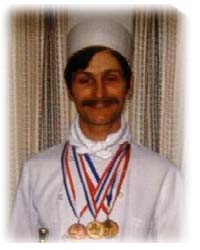|
Ingredients
1 (.25 ounce) package active dry yeast
1 cup warm water (110 degrees F/45 degrees C)
1/4 cup melted shortening
1 teaspoon salt
1 cup milk
2 tablespoons white sugar
6 cups all-purpose flour
Directions
1 Warm the milk in a small saucepan until it bubbles, then remove from heat. Mix in the shortening and sugar; stir until melted. Let cool until lukewarm. In a small bowl, dissolve yeast and sugar in warm water. Let stand until creamy, about 10 minutes.
2 In a large bowl, combine the milk, yeast mixture, shortening and 3 cups flour. Beat until smooth. Add salt and rest of flour, or enough to make a soft dough. Knead. Place in greased bowl, cover, and let rise.
3 Punch down. Roll out to about 1/2 inch thick. Cut rounds with biscuit cutter, drinking glass, or empty tuna can. Sprinkle waxed paper with cornmeal and set the rounds on this to rise. Dust tops of muffins with cornmeal also. Cover and let rise 1/2 hour.
4 Heat greased griddle. Cook muffins on griddle about 10 minutes on each side on medium heat. Keep baked muffins in a warm oven until all have been cooked. Allow to cool and place in plastic bags for storage. To use, split and toast. Great with orange butter, or cream cheese and jam.
This recipe here looks exceptional
Authentic English Muffins
This recipe makes for impressive, crusty, cornmeal-coated English muffins. The interiors are at once moist and holey, characteristically rough textured and hearty. A combination of unbleached bread flour (available at bulk food stores) together with some white whole wheat flour (or regular whole wheat). A smack of butter and honey round out the taste. Don't overlook these because they use a starter. It's child's play. Sure, there are easier ways to make English muffins but they taste like you took the easy way out. These are exceptional. A large cast iron pan makes for a perfect baking surface.
Four hour starter:
2 cups warm water
2 cups unbleached all-purpose flour
1/2 cup white whole wheat flour or regular whole wheat
3/4 teaspoon instant yeast
Sponge:
2 cups overnight starter - room temperature
3/4 cup warm water
1 teaspoon yeast
3/4 cup scalded milk, cooled
2 cups unbleached bread flour
Muffin dough:
Sponge mixture
4 cups (approx.) unbleached bread flour
4 tablespoons honey
2 1/2 teaspoons salt
4 tablespoons dry buttermilk powder (Saco - optional)
2 tablespoons corn flour or cornmeal
1/4 teaspoon cinnamon
Overnight starter:
In a medium bowl, stir together water and yeast. Let stand a couple of minutes to dissolve yeast. Stir in all purpose flour and whole wheat to make a thick batter. Cover and let stand 4 hours.
Sponge:
In a mixing bowl, stir together 2 cups of starter, warm water and dry yeast and allow yeast to dissolve for a couple of minutes. Stir in milk and bread flour to make a thick batter. Cover with plastic wrap and let stand 1 hour.
Dough:
Stir down batter and add the remaining starter, flour, honey, salt, buttermilk powder (optional) corn flour and cinnamon. Knead to make a soft batter (about 5 minutes).
Cover and let rise until almost doubled in bulk. Gently deflate dough. On a work surface sprinkled with cornmeal, roll or pat out to a three quarter inch thickness. Cut into 3 1/2 inch rounds using a cookie cutter. Place on a baking sheet, cover lightly with plastic wrap and let rise until almost doubled (about 45 minutes).
Heat a cast iron pan (medium heat). Sprinkle cooking surface with cornmeal. Gently arrange muffins to fit. Bake until bottoms are browned, about 5-8 minutes. Turn over and do remaining side, reducing heat if muffins are browning too quickly.
Cool well and split with the tines of a fork.
Makes 14-16 English Muffins. They freeze well.
For more 'holey' muffins, the dough must almost be a batter. Muffin rings can be purchased in a kitchen supply store - or, you may use large tuna cans (tops and bottoms removed). The rings support the loose batter and allow the muffins to retain their shape as they rise and bake.
Top
Food History Course
5 free E-Lessons
|
Come Explore with me
The History of Food
Have you ever wondered as I have.....
Who invented the first "Caesar Salad"?
How about the first salad or what was the first salad dressing?
How did Salad get the name Salad?
We explore different topics like famous restaurant dishes, famous fun foods like popcorn, famous Menus like Elvis's wedding reception, and popular food dishes that were invented by accident. Also tools and resources, that you can use to find information on different food and their origins
|
Just sign up here and you will get your first lesson instantly.
Click here to sign up
( We keep your address private )
|
Top | 
